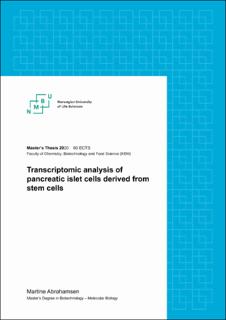| dc.contributor.advisor | Carlsen, Harald | |
| dc.contributor.advisor | Zarrouki, Bader | |
| dc.contributor.author | Abrahamsen, Martine | |
| dc.date.accessioned | 2021-01-28T20:34:28Z | |
| dc.date.available | 2021-01-28T20:34:28Z | |
| dc.date.issued | 2020 | |
| dc.identifier.uri | https://hdl.handle.net/11250/2725242 | |
| dc.description.abstract | Diabetes mellitus type 1 is an autoimmune disease leading to the destruction of the pancreatic beta-cells. The beta-cells are responsible for secreting the hormone insulin which lowers the blood sugar after a meal. Dysfunction and destruction of the beta-cells leads to an abnormal blood sugar regulation and hyperglycemia. Some papers have also put focus on the dysfunction of alpha cells in type 1 diabetes. The alpha cells are another cell type found in the pancreas and its job is to secrete the hormone glucagon to raise blood sugar levels to avoid hypoglycemia. Both cell types are found clustered together in the islet of Langerhans in the pancreas. From previous research we know that cytokines released by immune cells entering the islets play an important role in the pathogenesis of type 1 diabetes. Less is known on how each of the cell types react to them.
In this study we will differentiate SC-alpha and SC-beta cells from human induced pluripotent stem (iPS) cells as a source for human pancreatic endocrine cells. Then we will treat them and human islets from donors with cytokines, extract RNA and run qPCR on pre-selected genes. This will allow us to compare differences in gene expression between the cell types. We will use an immunoprecipitation (IP) protocol to pull out mRNA-ribosome complexes and compare this to full lysate samples to see the actively translated genes compared to the total transcriptome. Information on the transcriptome is a popular tool to observe the total RNA in a cell, and one can observe changes in the total gene expression in different states such as disease and drug-treatment. However, it fails to capture the fact that the total mRNA transcripts in the cell do not necessarily correlate with the mRNA levels translated. The translation profile, showing actively translated mRNAs, can reveal regulatory variations and can provide insight on the cells current physiological state. RNA-sequencing will be performed on all samples to see the active and the total gene expression profile for each cell type with and without cytokine treatment | en_US |
| dc.description.abstract | Diabetes mellitus type 1 er en autoimmun sykdom som resulterer i ødeleggelse av beta-cellene i pankreas. Beta-cellene er ansvarlige for sekresjon av hormonet insulin som senker blodsukkeret etter et måltid. Dysfunksjonen og ødeleggelse av beta-celler fører til unormal blodsukker-regulering og hyperglykemi. Noen forskningsartikler har også satt fokus på dysfunksjonen av alfa-celler i diabetes type 1. Alfa cellene er en annen celletype som eksisterer i pankreas. Alfa cellens jobb er å sekrere hormonet glukagon som øker blodsukkeret for å avverge hypoglykemi. Begge celletypene er samlet i klaser i Langerhans’ øyer i pankreas. Fra tidligere forskning vet vi at cytokiner frigjort fra immun cellene som bryter inn i Langerhans’ øyene spiller en viktig rolle i patogenesen til type 1 diabetes. Mindre er kjent om hvordan hver av celletypene responderer på de.
I denne studien vil vi differensiere SC-alfa og SC-beta celler fra humane induserbare pluripotente stam (iPS) celler som en kilde til humane endokrine pankreas celler. Deretter vil vi behandle de og humane Langerhans’ øyer fra donorer med cytokiner, ekstrahere RNA og utføre qPCR med forhåndsutvalgte gener. Dette vil gi oss mulighet til å sammenlikne forskjeller i gen ekspresjonen mellom de ulike celletypene. Vi vil bruke en immunpresipitering (IP) protokoll for å trekke ut mRNA-ribosom komplekser og sammenlikne dette med full-lysat prøvene for å observere de aktivt translaterte genene sammenliknet med det totale transkriptomet. Kunnskap om transkriptomet er ett populært verktøy for å observere alt RNA i cellen, og endringer i den totale gen ekspresjonen kan observeres som følge av endringer i situasjon slik som sykdom eller medikament-behandling. Den feiler imidlertid på å fange opp det faktum at den totale mengden mRNA i cellen ikke nødvendigvis korresponderer til mengden mRNA som blir translatert. Translasjonsprofilen, som viser aktivt translaterte mRNA, kan vise variasjoner i regulering og kan gi innsikt i cellens nåværende fysiologiske status. RNA-sekvensering vil bli utført på alle prøvene for å studere det aktive og den totale gen ekspresjonsprofilen for hver celletype både med og uten cytokin behandling. | en_US |
| dc.language.iso | eng | en_US |
| dc.publisher | Norwegian University of Life Sciences, Ås | en_US |
| dc.rights | Navngivelse 4.0 Internasjonal | * |
| dc.rights.uri | http://creativecommons.org/licenses/by/4.0/deed.no | * |
| dc.subject | ips cells | en_US |
| dc.subject | diabetes | en_US |
| dc.subject | type 1 diabetes | en_US |
| dc.subject | beta cells | en_US |
| dc.subject | alpha cells | en_US |
| dc.subject | human islets | en_US |
| dc.subject | pancreatic cells | en_US |
| dc.title | Transcriptomic analysis of pancreatic islet cells derived from stem cells | en_US |
| dc.type | Master thesis | en_US |
| dc.subject.nsi | VDP::Mathematics and natural science: 400::Basic biosciences: 470::Molecular biology: 473 | en_US |
| dc.source.pagenumber | 82 | en_US |
| dc.description.localcode | M-BIOTEK | en_US |

